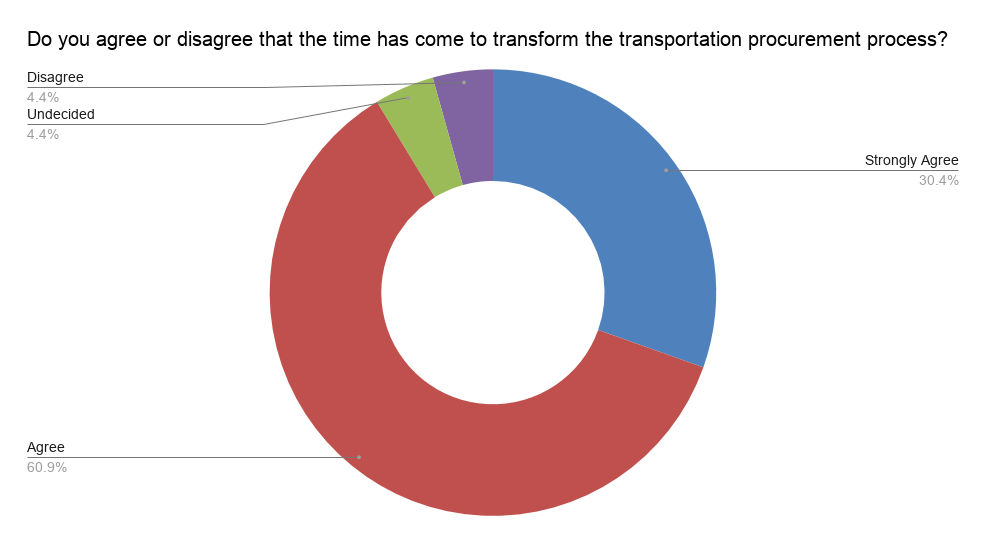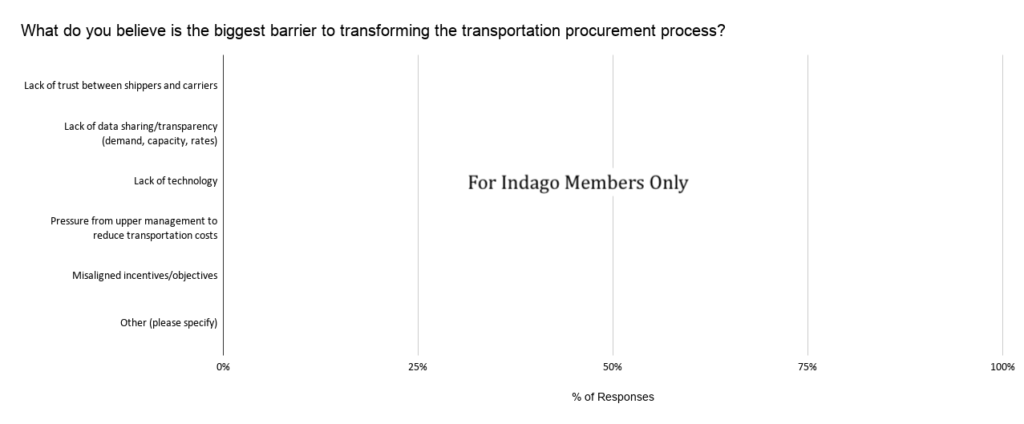Many companies are getting ready for (or perhaps have already completed) their annual transportation procurement engagement. But has the time come to transform the transportation procurement process?
We asked our Indago supply chain research community that question back in October 2020 and the vast majority of the respondents (91%) either Agree (61%) or Strongly Agree (30%) that the time has come to transform the transportation procurement process.

“During this time of extreme market volatility, we are working with our partner carriers to review rates on a more frequent basis to ensure we have capacity at market rates,” said one respondent. “Right now, we are reviewing and adjusting pricing every 2 – 4 weeks.”
The inspiration for our Indago survey question came from Dr. Chris Caplice at MIT, who in a presentation at the Manhattan Momentum Connect conference last year argued that “the dominant design in transportation procurement is now outdated and it’s time to transform the process.”
In a post published last month in Medium titled “In Search of Alternatives to Truckload’s Fragile Freight Contracts,” Caplice outlines an alternative approach to procuring truckload carrying capacity, which he calls Transportation Portfolio Management:
The central idea — which is not new — is that not every lane in a shipper’s network is equal, so why treat them as such when bidding them out? A more nuanced approach is to classify lanes according to where they are positioned between two extremes: those associated with consistent, balanced freight flows, and those where freight patterns are inconsistent and unbalanced. The type of lane is matched to the type of truck transportation best suited to carry the freight. Stable lanes are supported by dedicated fleets (trucks committed to respective lanes). Lanes in the middle of the spectrum are serviced by contract relationships (long-term contractual agreements with carriers). The spot market is reserved for unstable lanes.
A critical issue is how to structure the contracts within these different categories of lanes to make them enforceable. Current practice involves contracts that specify price and volume but ultimately are non-binding. There are alternatives, such as contracts that stipulate guaranteed volumes, or contracts based on tiered pricing schemes where the shipper pays different prices according to the volume of cargo carried in a lane by the day or week.
Another possibility is index-based pricing, where carriers’ rates are set in line with some mutually acceptable industry index. This concept is the foundation for adjustable-rate mortgages in the housing market. A corollary closer to the trucking world is the fuel surcharge, where shippers compensate carriers for fuel costs through a surcharge based on the prices listed in an industry index.
MIT’s Center for Transportation & Logistics FreightLab is actively looking for shippers and carriers to participate in its transportation contract research, so please contact them at freightlab@mit.edu if you’re interested in participating.
Moving away from “the way we’ve always done things” is always a challenge. In the same Indago survey, we asked our members — who are all supply chain and logistics executives from manufacturing, retail, and distribution companies — “What do you believe is the biggest barrier to transforming the transportation procurement process?” The results are available to Indago members only, but needless to say, there are plenty of hurdles.

What’s your experience or perspective related to transportation procurement? Do you agree with our Indago members that the time has come to transform the process? What do you think about the Transportation Portfolio Management approach proposed by Caplice? Post a comment and let us know!
Join Indago
Also, If you’re a supply chain or logistics practitioner from a manufacturing, retail, or distribution company, I encourage you to learn more about Indago and join our research community. It is confidential, there is no cost to join and the time commitment is minimal (2-5 minutes per week) — plus your participation will help support charitable causes like JDRF, American Logistics Aid Network, American Cancer Society, Feeding America, and Make-A-Wish.
You can also follow us on LinkedIn to stay informed of our latest research results and news.










